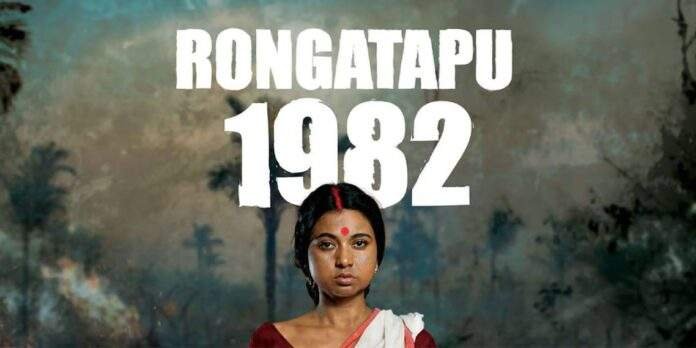“Rongatapu 1982” serves as a cinematic voyage into the tumultuous history of Assam, vividly portraying a landscape on the brink of explosion marked by religious disharmony and societal strife. This raw narrative skillfully weaves the stories of characters, predominantly women, caught in the throes of violence and upheaval, gasping for stability as their cherished lives teeter on the edge of obliteration.
The Compelling Tapestry of Characters In Rongatapu 1982
Morom and Jadab’s Struggle
The film intricately unfolds Morom’s (Aimee Baruah) poignant journey as a dedicated housewife on the verge of childbirth, grappling with the aftermath of familial tragedy. Her husband, Jadab (Gunjan Bhardwaj), an orphan shaped by the village, is torn between his responsibilities and the rising conflict threatening his community. The complexity of their relationship adds depth to the narrative, showcasing the personal costs of societal unrest.
Rupali’s Resilience and Unraveling Horrors
Kalpana Kalita’s portrayal of Rupali, a resilient young woman caring for her scarred sister Mala (Alishmita Goswami), brings to light the horrors that have left Mala emotionally battered. The film skillfully intertwines Rupali’s dreams of love with Madhab (Vivek Bora) and the harsh realities she faces. Mala’s unspoken trauma becomes a central enigma, inviting the audience to delve into the mystery of her vulnerability.
Rafiza’s Desperate Struggle
Rimpi Das delivers a powerful performance as Rafiza, a woman impregnated against her will, navigating a society where women endure deplorable conditions. Rafiza’s internal conflict, fearing the repercussions of her child’s gender in a hostile environment, adds a layer of complexity to the narrative. The film sheds light on the desperate struggles of women on the fringes of societal upheaval.
Navigating Challenging Terrain
Bold Subject Matter and Controversy
“Rongatapu 1982” confronts a bold and challenging subject, addressing societal issues among outsiders without explicitly naming the community. Adityam Saikia’s fearless approach, though commendable, invites criticism for its restrained portrayal and one-sided focus. The film grapples with the difficulty of depicting societal evils and violence perpetrated by outsiders, navigating the thin line between realism and controversy.
Fractured Narrative Flow
While Saikia captures the essence of the time period, his cautious approach to storytelling results in a fractured narrative flow. The film, presented to those unfamiliar with the historical context, may induce confusion and a lack of understanding. The restrained portrayal, coupled with shaky storytelling, creates a challenging viewing experience for those without regional insights.
Powerful Performances and Character Dynamics
Aimee Baruah’s Gripping Portrayal
Aimee Baruah’s portrayal of Morom is a testament to her ability to embody the anguish of a tortured housewife. Building on her previous roles, Baruah’s nuanced performance draws viewers into Morom’s world, particularly shining in her depiction of grief, which is both haunting and authentic.
Gunjan Bhardwaj’s Unveiling Secrets
Gunjan Bhardwaj’s underutilized talent finds expression in Jadab, a character shrouded in undisclosed secrets. Bhardwaj’s performance leaves subtle hints about Jadab’s awareness of his past, adding layers to the character. His awkward mannerisms and behavior contribute to the character’s uniqueness, leaving an indelible mark.
Rimpi Das’s Riveting Rafiza
Rimpi Das delivers an outstanding performance as Rafiza, encapsulating the torment of a woman trapped in an inescapable situation. Through Das’s portrayal, Rafiza’s emotional journey becomes a focal point, showcasing the impact of societal horrors on an individual.
Kalpana Kalita and Alishmita Goswami’s Compelling Duo
The dynamic between Kalpana Kalita and Alishmita Goswami as sisters Rupali and Mala is exceptional. Alishmita’s silent portrayal of Mala’s past horrors is chilling, conveying more than words could. Kalpana’s depiction of Rupali’s internal conflict adds emotional depth, leading to a heart-wrenching conclusion.
Captivating Cinematography
“Rongatapu 1982” stands out for its breathtaking cinematography, capturing the essence of 1980s Assam village life. The camera skillfully navigates between panoramic shots and detailed depictions of daily routines, immersing viewers in the organic elements that define the era.
Evocative Sound Design
The film’s proficient sound design complements its visual splendor, recreating the bustling sounds of village life. The auditory experience adds life to the visuals, creating a holistic portrayal of the Assamese village in the 1980s.
Editing Shortcomings
Despite technical brilliance, the film is marred by editing shortcomings. Jerky transitions disrupt the flow, detracting from the immersive experience. These flaws momentarily remind the audience of the film’s artificial nature, interrupting the illusion of a real-life tableau.
Conclusion
“Rongatapu 1982” emerges as a bold exploration of Assam’s turbulent history, offering a raw and unfiltered lens into a period marked by violence and societal unrest. While its restrained approach may pose challenges for those unfamiliar with the context, the film’s powerful performances, captivating visuals, and evocative sound design contribute to a compelling cinematic experience. Adityam Saikia’s fearless handling of a challenging subject, despite facing potential criticism, makes this film a noteworthy addition to the cinematic landscape.
ALSO READ: OPPENHEIMER’S POWERFUL REVIEW AND THE CLASH OF IDEOLOGIES: UNRAVELING DIFFERENCES











